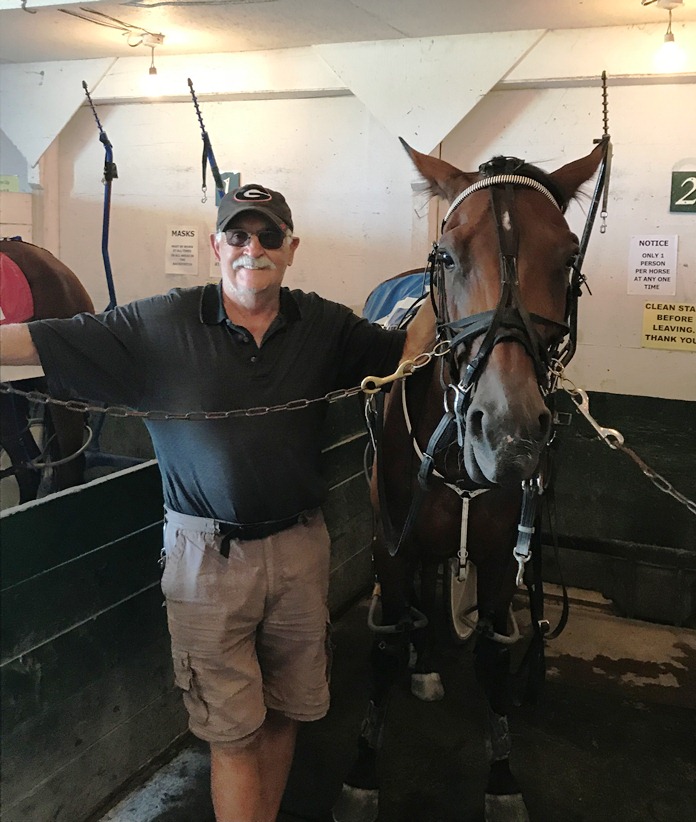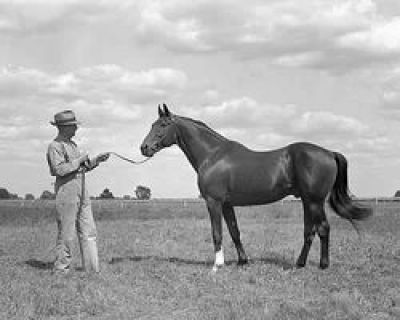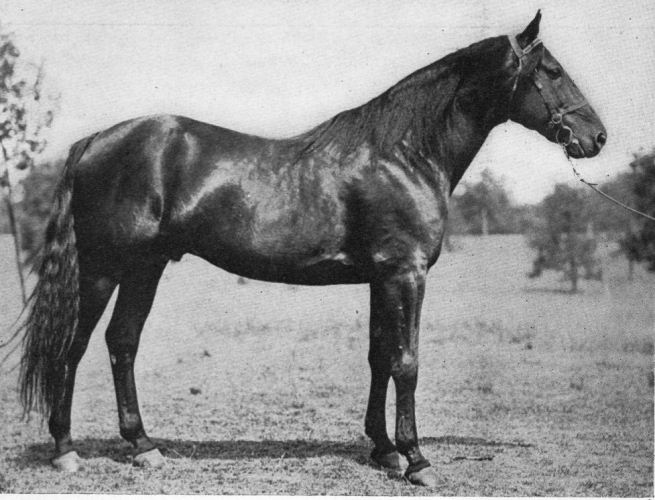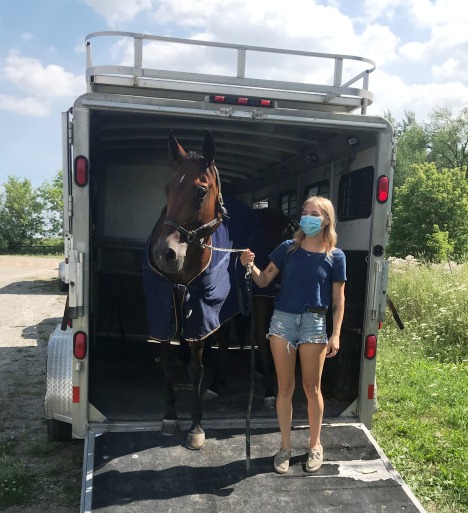Rusty's Flying
Rusty's Flying, a mare with true grit, wins her 100th race!
Webster's Dictionary says grit indicates firmness of mind, invincible spirit, unyielding courage, fortitude.When a unassuming mare, runs 340 races, winning 100 of them, in her twelve years, she certainly fulfills the definition of true grit. This is the subject of our piece, a Standardbred mare named Rusty's Flying, who while racing at an ordinary level on the circuit, never in a stakes race, grinded out her 100th win in 340 starts (56 2nd, 54 3rd). The humble and uncelebrated Rusty's Flying entered the history books this July 2020 when she won her 100th race. There was little fanfare, racing in front of empty bleechers because of virus restrictions, in an ordinary claiming race in Ontario, she did what she did best: held on to her lead and crossed the finish line first.

[Rusty's Flying all tacked up and ready to go with her owner Glenn Tarver-photo courtesy of Glenn Tarver]
My thanks goes to Richard Abraham, a steadfast track fan in Canada, who witnessed her 99th victory in June and emailed me to see if I might be interested in her accomplishment. Of course I was thrilled that a mare was about to break the 100th win ceiling, and I asked Richard to keep me posted. There was very little press on her, even after Richard alerted me, I searched online for information on her and there was hardly a whisper. She just wasn't flashy enough I guess, maybe because she ran at the plebeian level, and in Canada, and unlike Foiled Again a few years ago, no one seemed to be watching. To me she is a star.
It was just two years ago I conducted a lengthy study into durability and soundness in the racehorse breeds, which was inspired by the Standardbred gelding Foiled Again's 100th win, and the study reaped some astonishing results. At the time there were 24 Standardbreds, geldings and stallions--no mares, that I was able to find who had won 100 or more races (starting in 200 to 600!). In comparison I had a very difficult time finding any Thoroughbreds or Quarter Horses that even ran 100 times, and certainly only one Thoroughbred who won 100. Obviously then there was something unusual and important about the Standardbred, and I thought if we could find where their genetic edge arose from, that it would ultimately help all sport horse breeders. So I began the durability and soundness project. If you are interested in bloodlines that transmit soundness and durability, then you will need to allow some time to read the entire study, it is quite lengthy, but I hope you will find it of interest. For brevity here I concluded the study in part with: "There is a notable and measurable higher percentage of durability and athleticism coming from the Standardbred population in comparison to the Quarter Horse and Thoroughbred...It is the Standardbred that is more concentrated in the root Running Horse than the other two. Second, the Standardbred has less inroads of less sporty stock." (Conclusions for Soundness and Durablity Study" Part III).
That study was done with 24 known century mark winners. Now we will have to add not just the incredibly tough Rusty's Flying, but another mare that I missed first time around: Lady Netty N.
Richard put me in contact with Glenn Tarver, Rusty's owner, and he has graciously answered my many questions about his mare. He has nothing but admiration for this very special racer. When I asked him to tell me what she was like, Glenn said that there is a stubborn streak in her disposition, and she doesn't like to be messed with, but when she is racing she is all business with her ears up, eager to race, she actually seems to live to race, and she pulls hard to win every time. She has had some injuries over the years, but she heals up and gets right back out there. She is not high maintenance, an incredibly reliable horse; he says she never gives less than 100%. Glenn says she is a "blue-collar horse that works hard for her money." Sounds like true grit to me.
Glenn forwarded me the few Standardbredcanada.ca articles that had been written about her. Her trainer, David Gibson, had been interviewed in 21/21/19 where he described her as "one of those grinding-type horses...she will just keep digging right to the wire and give you everything she's got... I wish I had a barn full of horses like her." He also said, "she's the type of mare that when she is in a race and she is going head-to-head with a horse, she won't give up." About her temperament, he said she is a little quirky, but he says she deserves respect, and he tries to keep her happy. She does not like to be cooped up...in a stall she is apt to pace back and forth...she prefers outdoors in a paddock of her own. So here we have a mare with obvious nervous energy, chomping at the bit if you will, to get out there and race, it's her sole mission, to race.
Her mental quirks, from my limited experience researching special horses, seem to be a common component of the upper level achievers, those that have true grit. For instance, the recently deceased Senior Senator, a steeplechase overachiever, died of colic, a condition which plagued him especially if he was not in training...he too hated to be penned up, and they found it best to keep him in a paddock and in training. I don't think my hero Foiled Again was quite as quirky as these two, but he also seemed to live to race, and just as resolutely would give it his all. Racing lore is full of top horses that had to be handled carefully, Ribot for instance was a true crazy horse, Nasrullah was a nervous handful, Hamburg had to be kept in hard training and fed continuously, and the great show jumper Halla was too difficult for most riders, and so on. So let's take a look at her genetics through her pedigree and see how she measures up to the rest of the centurions including Lady Netty N.
Pedigree Analysis
Rusty's Flying 2008, has a definitive pedigree design, where the pacing elements are strongly in the fore, with Hal Dale leading the way (26 lines in the 6th through 9th generation), followed by his son Adios (11 lines in the 5th through 7th), and then the modern day phenomenon Meadow Skipper 6x5x5x6x6x6, all these lines are sex balanced, and at critical mass level. There is a secondary trotting presence via the 30 lines of the great Volomite found further back in the 7th - 9th and the ambivalent Billy Direct, a pacer with a strong trotting factor (22 lines). And Rusty was a pacer, who reflected the genetic depth of her lineage; as she had a passion to race.

[Hal Dale, powerful pacing line in the Standardbred]
The background lines mentioned above rule the genetics because of their sheer number and position of their presences carry more weight then the closer elements. That said, it is very notable that Rusty has some powerful full and 3/4 sibling configurations closer up that act as a laser focus of that background power. Ultimately, with the exception of some close inbreeding: 3/4 siblings Warm Breeze/Sandys Sable 3x4 and the 3/4 siblings Al Dente/Race Time 3x5, and because both these intense concentrations include the damline, it may have something to do with the Rusty's intenseness (mtDNA). A little further back is the Triple Crown winner Bret Hanover and his 3/4 siblings Tarport Cheer/Carolonda/Queens Crown/Henry T Adios 5x4x4x5x5x5, strongly coming forward. Rusty is an extremely potent genetic package.
Rusty is most definitely a Hal Dale mare, with a Volomite secondary influence (Kings Counsel, On Time, Worthy Boy), with the great Meadow Skipper double and the close sibling formations funneling the power forward.
What about the other mare that won 100 races? Lady Netty N 1988, was bred and born in New Zealand, she won one race while there and then was shipped to the States where she won an additional 99 races--with the last win on the eve of her mandatory retirement of 15. I didn't find this mare when I did the initial study, perhaps because her wins were divided up on two continents. Born thirty years before Rusty, she was the only known mare in modern times to reach the century mark...that is until Rusty did it last week.
I built out her pedigree so I could compare it with Rusty's, thinking I would find consistency. Instead what I found was that the Lady has almost a flip of Rusty's points--like a mirror image. Her main dominance is in the trotter Volomite and his family, with Hal Dale and his pacing descendants present but definitely sitting in second place.

[Volomite, a trotter with a strong pacing element.]
Lady has an unambiguous critical mass in Volomite, with 10 lines in the 4th through 8th. Her second strongest presence is his son LIght Brigade, a trotter, 4x4, then surprisingly the volume of Volomite's grandfather, Peter the Great, 33 lines in the 6th through 10th, reaches forward in critical mass. Volomite's sire Peter Volo, 15 lines, is next in potency providers. Hal Dale (6 lines) and his son Adios 4x6 are present but take a back seat.
Looking at this genetic design, I was confident that the Lady was a trotter. But when I was finally able to locate an article about her retirement and entry in to the Hall of Fame, the picture was unclear to me--I couldn't be certain if she was pacing or trotting, and it got worse the longer I stared at it. So I searched for her in databases, and found her listed as a pacer. It can't be! And to tell you the truth I am not 100% convinced yet. But there it is, I guess the people holding the races know what gait is being used!
So, I had to reexamine her pedigree, and her sire No Fission was indeed a pacer, but the power behind her still said 'trot' to me. I have discovered that many of these bloodlines, while the horse might be classified as a pacer or trotter, the genetics in the horse can go either way. For example, Lady's strongest potency comes from Volomite, who raced as a trotter, but as a stallion produced an equal amount of pacers to trotters. The balance between the trot and the pace then was pretty thin. And his son Peter Volo, a trotter, also produced more than a few pacers, and of course, the grandsire, Peter the Great, the greatest sire in the history of the breed, was mixed-gaited. Peter the Great's son Peter Scott heads a strong family of trotters (see Standardbred and Soundness for details).
Taking a step back in Lady's lineage to her second strongest potency, Peter the Great, we find he was a horse that was despised by his owner, Malcolm Forbes, because he was mixed-gaited. Mixed-gaited means the gaits appear interchangeable, and a horse will switch back and forth randomly, and it is extremely difficult to get them to hold one or the other. This is different from dual-gaited, where a horse can race in either form, holding the trot all the way to the line or the pace as it is asked for. The great foundation George Wilkes AT was dual-gaited, and he could race at either the trot or the pace, and he passed on clean gaits as well. It is not that unusual really, the trotting record setter, Nancy Hanks was also dual-gaited. And even in our gallopers, it used to be quite common in the 1800s to have horses that could race at both the trot and gallop and win in each, examples like the great four-mile heat racer Planet RH, Bishops Hambletonian RH, or Millers Damsel RH, the dam of American Eclipse, or General Grant's favorite charger Cincinati RH. So, here we have Lady, with the flip of Rusty's genetic dominance and she too won her races at the pace.
But how do these century mark mares compare to the original 24? They reflect the very same main genetic dominance; it boils down to Hal Dale and Volomite and their successful families. "There are three main bloodlines that are represented: Hal Dale ST and his son Adios ST are the strongest presence...second in potency is Peter the Great ST and his son Peter Volo ST mainly through his son Volomite ST.." (Part I Soundness and Durability). The addition of the two mares changes the overall percentage of pacers from 87% to 88% over trotters.
The inability to identify which gait may manifest is not just a breeder's problem, even science, while they have been able to identify the gene that allows the horse to race at full speed at the mid-gait, it has failed so far to isolate the genetic factor that manifests trot or pace. People want things cut and dried, in neat packages. Several years ago I was forced to confront the industry narrative being pushed on gaitedness, and after much study, came away learning that the ability to pace is not exclusive to the ability to trot---as we saw above there are more then a few famous horses that could do both equally well (another example is Jay-Eye-See who set a record at both gaits), and vise-versa, plus contrary to the popular wisdom, it does not impede the canter or gallop (as we saw in several examples above). What it most surely does is allow the mid-gait to be maintained at racing speed, and make it the dominant gait of the horse. I traced the gaited trait from the early 1600s (1611) in this country up to modern times, and learned much in the process (see Standardbred Sport Horses and Become Your Own Tesio).

[Rusty being led off the trailer by Cassie Armstrong--photo courtesy of Glenn Tarver.]
John Wallace noticed the connection between the two forms back in the 1800s and took a lot of heat when he dared to mention that the speed characteristic appeared to arrive with the pace. His statements of this started an outright civil war in the developing breed, as a strong contingent religiously believed all speed originated with the Thoroughbred. Turns out Wallace was right after all, that the speed trait can be traced back even in the Thoroughbred to the original foundations mares that, surprise, were not Arabian or any other Oriental, but what science calls 'native English mares', which is what made up the pre-TB racing studs, Irish Hobby and English Running Horses--gaited race-saddle horses! And it was those very same pre-TB race horse breeds that made up the early imports in to our colonies (see American Running Horse).
Today a full 2/3 of the breed are pacers; a ratio accomplishment of some wonder because the early controllers of the American Trotter (pre-Standardbred breed) tried to purge the pacing strains from the gene pool from approximately 1820-1890, and blocked the entry of pacers into the registry and banned them from the trotting tracks. Why couldn't they succeed in eliminating the pace? One clue is that the mid-gait racing breed began as a pacer, and the trot only came about from outcrossing with trot transmitters. When the 1800s arrived roads were being built and improved, and the carriage horse was in demand then, and they preferred trotters for that function. Therefore the great trot 'typesetters' became essential for their goals. Messenger EH (English Hunter--not a full TB), his great-grandson Hambletonian AT (inbred to Messenger 6 times), and the coarse Mambrino Chief were favored to guarantee a clean trot. These bloodlines became very important because they reliably set the trot, but overall they had less speed, agility and soundness than the gaited foundations and stock they were bred to which might explain why science found that the pace is faster then the trot, and the pacer is sounder then the trotter (see intro for study). And in our examination of horse that could race 200 to 600 times and win over 100 of those contests, that the pacer fills out 88% of those achievers.
Breeders of sport horses, those that can jump, run cross country and perform dressage, can't conceive of the gifts the Standardbred has for them--they are blinded by its harness racing persona, and of course it is 'gaited'. Yet of all the sport breeds in the world, I believe the Standardbred is the only one that is homozygous for both the speed and stamina gene, plus it is an exceptionally sound breed, with overall a sweet temperament and strong work ethic, good athletic conformation, terrific legs and feet, and excellent movement, and yet the idea of crossing it in to their herds never occurs to them.
Links:
World Games
References:
Huff, Rosie "Florida Hall of Fame member Lady Netty N, 30, Dies" http://ustrottingnews.com/
Kirsan, Kathleen www.sport-horse-breeder.com/soundness.html : "Foiled Again--Introduction", "Part I Standardbred and Soundness", "Part II--Thoroughbred and Soundness", "Part III The Durable and Sound Quarter Horse" "Conclusions for the Soundness and Durability Study" "Soundness and the Breeder", www.sport-horse-breeder.com/gait-keeper.html, Standardbred Sport Horses 2017
https://standardbredcanada.ca "Rusty's Flying Ties Win Record" 7/18/20, "Flying Under the Radar" 12/21/19
Tarver, Glenn (owner of Rusty's Flying) series of phone and emails